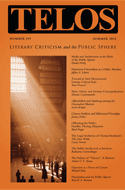Jaimey Fisher’s “Citizen Soldiers and Militarized Nostalgia: Genres of War and Place in the 1950s Public Sphere” appears in Telos 159 (Summer 2012). Read the full version online at the Telos Online website, or purchase a print copy of the issue here.
 One of the most celebrated postwar German films, Bernhard Wicki’s The Bridge (Die Brücke, 1959), has garnered remarkably little scholarly attention, but the film both reflects and engages fundamental changes in the German public sphere in the 1950s and 1960s. It has traditionally been assumed (right through the present) that the 1950s was an era driven by an emphatic forgetting of Germany’s criminal wartime past, but recent work reflects a turn in our understanding of the 1950s thinking about this past. It is now increasingly acknowledged that 1950s society and culture did engage the past, but in often highly refracted ways. One of these ways comes into focus with the cinema, particularly in the dominant genre cinemas of the 1950s. While the so-called Heimatfilm has dominated scholarly thinking about film in this era, the war film (as the second most popular genre of the decade) was also a crucial means to represent, but also distort, memories of the Nazi period. The essay considers the role of the war film in the public sphere as well as the representation of the public sphere, and its politics, within the war film genre. The small-town counter public sphere detailed in The Bridge, in fact, shows the film’s engagement not only with the recent war and 1950s memory culture, but also with that other most popular genre of the time, the Heimatfilm.
One of the most celebrated postwar German films, Bernhard Wicki’s The Bridge (Die Brücke, 1959), has garnered remarkably little scholarly attention, but the film both reflects and engages fundamental changes in the German public sphere in the 1950s and 1960s. It has traditionally been assumed (right through the present) that the 1950s was an era driven by an emphatic forgetting of Germany’s criminal wartime past, but recent work reflects a turn in our understanding of the 1950s thinking about this past. It is now increasingly acknowledged that 1950s society and culture did engage the past, but in often highly refracted ways. One of these ways comes into focus with the cinema, particularly in the dominant genre cinemas of the 1950s. While the so-called Heimatfilm has dominated scholarly thinking about film in this era, the war film (as the second most popular genre of the decade) was also a crucial means to represent, but also distort, memories of the Nazi period. The essay considers the role of the war film in the public sphere as well as the representation of the public sphere, and its politics, within the war film genre. The small-town counter public sphere detailed in The Bridge, in fact, shows the film’s engagement not only with the recent war and 1950s memory culture, but also with that other most popular genre of the time, the Heimatfilm.


